

The game of life and death inside the cell: exploring the Mystery of Pyroptosis
Pyroptosis Definition and Characteristics
Pyroptosis is a new mode of programmed cell death that relies on Gasdermin family proteins for the formation of plasma membrane pores and regulated cell death, often but not always accomplished by activation of inflammatory caspases.
Its morphological features can be clearly seen under the electron microscope, before the rupture of the cytoplasmic membrane, Pyroptotic cells form numerous vesicles, i.e. pyroptotic body. Then pores are formed in the cell membrane, which ruptures and the contents flow out.
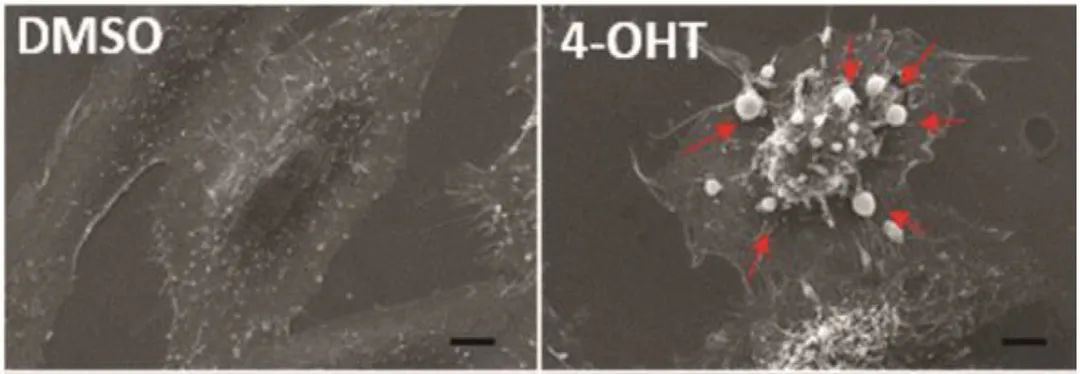
Electron micrograph of Pyroptosis Source [1]
Difference between Pyroptosis & Apoptosis
|
Characteristics |
Pyroptosis |
Apoptosis |
|
Trigger inflammation |
✔ |
✘ |
|
Apoptotic body |
✘ |
✔ |
|
Pyroptotic body |
✔ |
✘ |
|
Intact nuclear |
✔ |
✘ |
|
Plasma membrane forming pore channels |
✔ |
✘ |
|
Cellular swelling |
✔ |
✘ |
|
Cellular shrinkage |
✘ |
✔ |
|
Osmotic cleavage |
✔ |
✘ |
Pyroptosis Detection Methods
Morphocytology: Based on the changes in cell morphology, preliminary identification of whether cells have undergone pyroptosis. Through light microscope observation, cytoplasmic rupture or the existence of large amounts of cellular debris can be seen.
LDH release detection: Lactate dehydrogenase (LDH) is an enzyme present in almost all cells. When the cell membrane is broken, LDH can be released into the culture medium. Therefore, the presence or absence of pyroptosis can be determined by detecting the concentration of LDH in the culture medium.
DNA fragmentation detection: Determine whether the cell is apoptotic by detecting the cleavage and fragmentation of DNA after pyroptosis, such as DNA gel electrophoresis, DNA chromosome fragmentation interruption PCR, etc.
ELISA detection of inflammatory factors: Pyroptosis is a special death mode caused by various environmental or drug stimuli, which will release a series of inflammatory factors and trigger an inflammatory response. Common indicators: IL-1β, IL-6, IL-18. By using specific antibodies, the content of these inflammatory factors can be measured to determine the degree of pyroptosis.
WB test: By detecting a single protein, key molecules in pyroptosis can be detected, such as Caspase-3, PARP, etc. for quantitative detection.
Pyroptosis Pathway
Typical pathways mediated by caspase-1:
In the pyroptosis pathway, after being activated by NLRP3, NLRC4, AIM2, Pyrin and other inflammasomes, they will activate and cleave Pro-Caspase-1 to form active Caspase-1. Caspase-1 can cleave GSDMD protein to form active N-terminus and C-terminus, N-terminus promotes cell membrane perforation and cell death, at the same time, Caspase-1 can also process pro-IL-1β to form active IL-1β, which is released to the extracellular area to expand the inflammatory response.
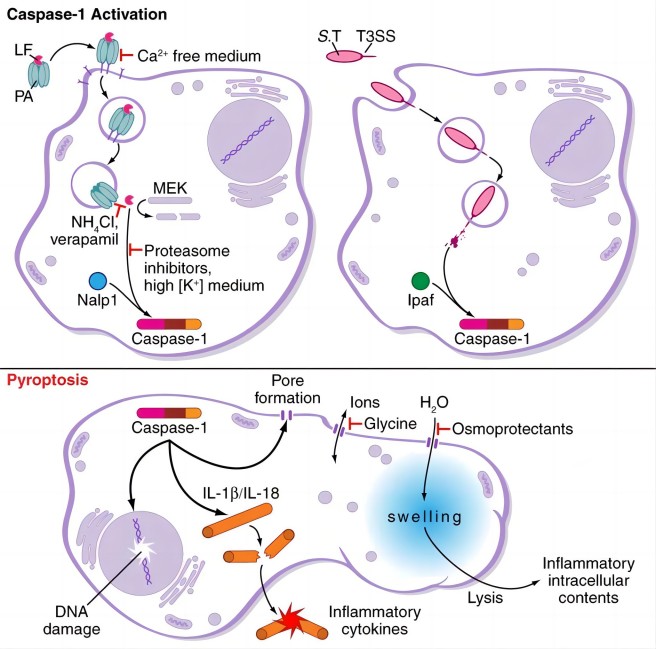
Different pathways activate Caspase-1 trigger Pyroptosis Source[2]
Atypical pathways mediated by caspase-4/5/11:
In the atypical pyroptosis pathway, LPS can directly bind Capase-4/5/11. On the one hand, activated Caspase-4/5/11 can cleave GSDMD protein, the N-terminus of GSDMD protein can mediate both cell membrane dissolution and pyroptosis. It also activates NLRP3 inflammatory vesicles to activate Caspase-1, which ultimately produces IL-1β and external releases. On the other hand, the activated Caspase-4/5/11 activates the channel Pannexin-1, releases ATP to open the membrane channel P2X7, and makes the cell membrane form small pores to induce pyroptosis. The activated Pannexin-1 also activates NLRP3 inflammasome by releasing K+, finally producing and releasing IL-1β.
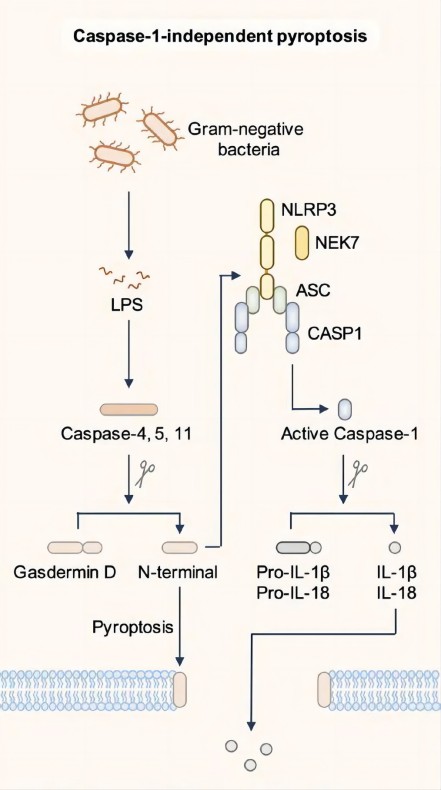
Atypical pathway of pyroptosis Source[3]
Caspase-3-Gasdermin E (GSDME) pathway:
The study found a new pyroptosis pathway: specific stimuli lead to the activation of Caspase-3 (originally Caspase-3 is the substrate of apoptosis), and Caspase-3 induces the cleavage of Gasdermin E (GSDME) into C-terminal fragments (GSDME -CT) and the N-terminal fragment (GSDME-NT). GSDME-NT is also involved in the formation of membrane pores, leading to pyroptosis.
Granzyme-mediated pathway:
Studies have found that Granzyme A (GZMA) secreted by cytotoxic lymphocytes cleaves GSDMB to release GSDMB-N fragments, causing cell perforation, and thereby inducing pyroptosis. This research refreshes the definition of pyroptosis and rewrites the conclusion that pyroptosis can only be activated by Caspase.
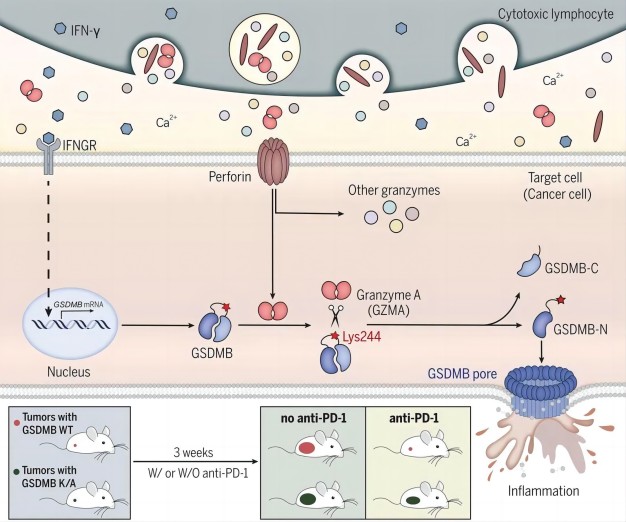
GZMA cleavage of GSDMB induces pyroptosis Source[4]
Pyroptosis Research Area
Pyroptosis and Tumor
Pyroptosis is not only a physiological regulator of cell proliferation, stress response, and homeostasis in vivo, but also a tumor suppressor mechanism, and induction of tumor pyroptosis has become one of the pathways of anti-tumor immunity. In addition, pyroptotic tumor cells release inflammatory factors into the microenvironment, which may play a role in promoting tumor immunity.
Pyroptosis and Diabetes
NLRP3, a member of the PRR family, plays a key role in the progression of both type 1 and type 2 diabetes. In a mouse model of type 1 diabetes, knockout of NLRP3 and IL-1R upregulated insulin and effectively alleviated hyperglycemia symptoms. In type 2 diabetic mouse, overexpression of NLRP3 exacerbates adipose tissue inflammation, decreases insulin sensitivity, and promotes insulin resistance. It suggested that NLP3-mediated pyroptosis could be used as a new target for the treatment of diabetes.
Pyroptosis and Heart Disease
Pyroptosis mediated by NLRP3 inflammasome activation can promote the development of various cardiovascular diseases such as atherosclerosis, heart failure, and hypertension. The pathological basis of cardiovascular disease - atherosclerosis, is actually an inflammatory response process. Many research reports have shown that pyroptosis may be closely related to the development of atherosclerosis.
Pyroptosis Antibody Selection
As a professional antibody manufacturer, ELK-biotechnology has excellent antibody performance and comprehensive index coverage. Aiming at the direction of pyroptosis, ELK-biotechnology specially brings together pyroptosis-related products for you, hoping to help your experiments progress more efficiently!
Pyroptosis Related Products List
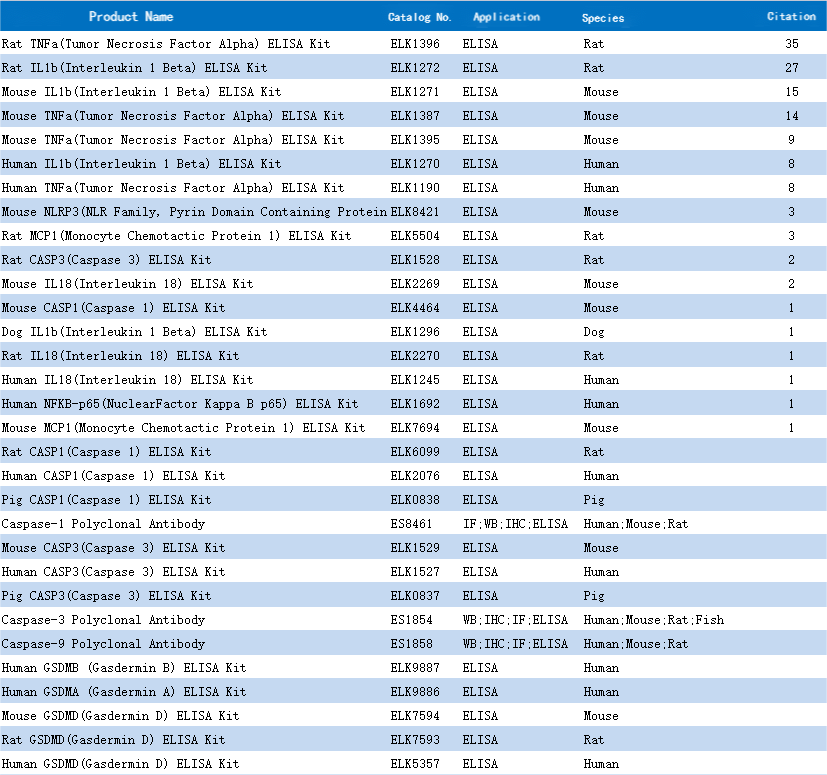
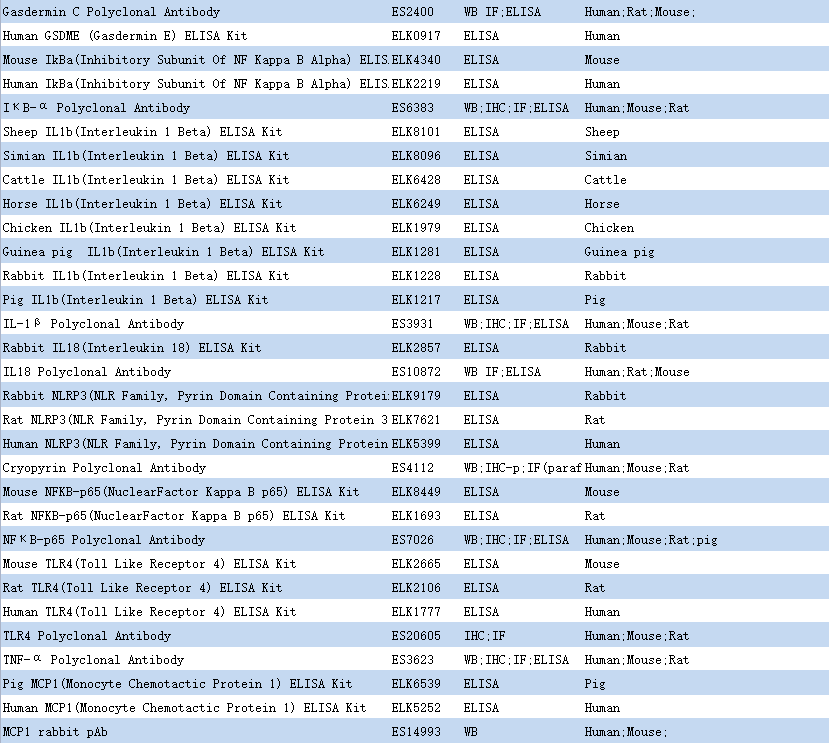
Reference documentation:
1.Chen X, He WT, Hu L, Li J, Fang Y, Wang X, Xu X, Wang Z, Huang K, Han J. Pyroptosis is driven by non-selective gasdermin-D pore and its morphology is different from MLKL channel-mediated necroptosis. Cell Res. 2016 Sep;26(9):1007-20.
2.Fink SL, Bergsbaken T, Cookson BT. Anthrax lethal toxin and Salmonella elicit the common cell death pathway of caspase-1-dependent pyroptosis via distinct mechanisms. Proc Natl Acad Sci U S A. 2008 Mar 18;105(11):4312-7.
3.Man SM,Kanneganti TD.Gasdermin D:the long-awaited executioner of pyroptosis[J].Cell Res,2015,25(11):1183-1184.
4.Zhou Z, He H, Wang K, Shi X, Wang Y, Su Y, Wang Y, Li D, Liu W, Zhang Y, Shen L, Han W, Shen L, Ding J, Shao F. Granzyme A from cytotoxic lymphocytes cleaves GSDMB to trigger pyroptosis in target cells. Science. 2020 May 29;368(6494):eaaz7548.
ELK-biotechnology
Homepage: www.elkbiotech.com
Email: ELKbio@ELKbiotech.com
Tel: +12127290609


